

ObjectRelationalMapping. Creation design patterns. Ruby Primer: Ascent - Instance Variables and Accessors. An object can't exist in isolation.
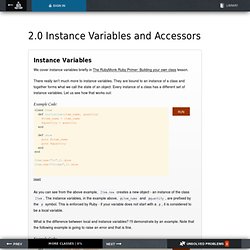
It has to communicate its state to other objects at some point. However, only the object's own methods can access its instance variables. So, you can have methods known as 'getter' methods whose sole purpose is to return the value of a particular instance variable. Let us see an example: The getter method here is the item_name method. Having to explicitly define getter methods ensures that the object is always in control of how your state is exposed to the public. We hark back on our Item class yet again for this exercise. So far we talked about accessing the contents of an instance variable through getter methods. To execute the statement item.color = 'red', Ruby invokes the the method Item#color= and passes the value 'red' to it. In the following exercise, I've defined a stub for the setter method quantity=.
Ruby Access Control: Ruby Study Notes - Best Ruby Guide, Ruby Tutorial. The only easy way to change an object's state in Ruby is by calling one of its methods.

Control access to the methods, and you have controlled access to the object. A good rule of the thumb is never to expose methods that could leave an object in an invalid state. Learning Ruby. Now we are ready to create our very own Address class.
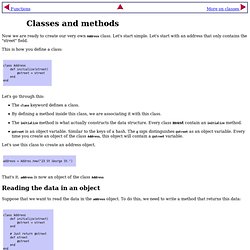
Let's start simple. Let's start with an address that only contains the "street" field. A Guide to Ruby Collections Archives. Ruby Programming/Syntax/Literals. Erik Trautman's world of startups, creativity and code. This post will dive into map and select and all the other handy methods you get from Enumerable, Ruby's most useful module You've learned about Array and Hash but only got half the story... they each have their own methods for adding and deleting and accessing data and they both implement their own version of the #each method to iterate over their items but what makes them really powerful in Ruby is the ability to use Enumerable methods as well as the basic ones you've just learned.
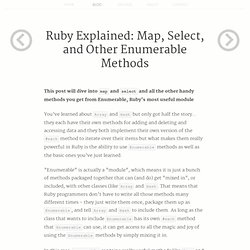
"Enumerable" is actually a "module", which means it is just a bunch of methods packaged together that can (and do) get "mixed in", or included, with other classes (like Array and Hash. That means that Ruby programmers don't have to write all those methods many different times - they just write them once, package them up as Enumerable, and tell Array and Hash to include them. > [1,2,3].each { |num| print "#{num}!
" } 1! Ruby: what does %w(array) mean? Ruby QuickRef. Table of Contents Language General Tips These are tips I’ve given over and over and over and over… Use 2 space indent, no tabs.
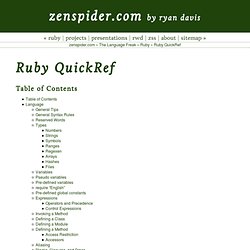
Use [] over Array.new. See for more. General Syntax Rules.
Collect (Array) Ruby: How to iterate "the right way" - Jerome's Adventures in Rubyland. You may be baffled by this quote if you come from a C-flavored language such as C++ and Java, where explicit loops like for and foreach are part of your everyday life.
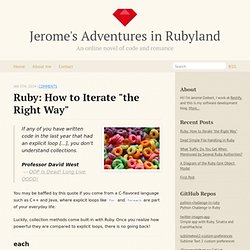
Luckily, collection methods come built-in with Ruby. Once you realize how powerful they are compared to explicit loops, there is no going back! Each Let’s begin with the collection method that has the least added value.each is the equivalent of a for loop. Flatiron School Prework - Main. Ruby Programming Challenge for Newbies. Ruby Basic Tutorial. Troubleshooters.Com, Code Corner and Ruby Revival Present Ruby Basic Tutorial Copyright (C) 2005 by Steve Litt Note: All materials in Ruby Revival are provided AS IS.
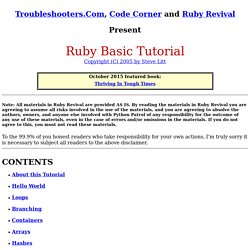
By reading the materials in Ruby Revival you are agreeing to assume all risks involved in the use of the materials, and you are agreeing to absolve the authors, owners, and anyone else involved with Python Patrol of any responsibility for the outcome of any use of these materials, even in the case of errors and/or omissions in the materials. If you do not agree to this, you must not read these materials. To the 99.9% of you honest readers who take responsibility for your own actions, I'm truly sorry it is necessary to subject all readers to the above disclaimer. Learn Ruby - Variables, Strings, Numbers. Create an account to comment hkxnyc * 2 days ago not a big deal but jadakiss is spelled without the y. thanks for these quizzes :) feek1g * 7 days ago.
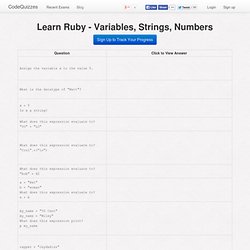
Ruby Tutorial: Ruby Study Notes - Best Ruby Guide, Ruby Tutorial. RubyLearning.com.
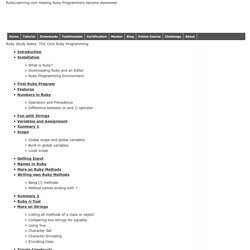
Courses. Ruby Tutorial. Ruby is a scripting language designed by Yukihiro Matsumoto, also known as Matz.
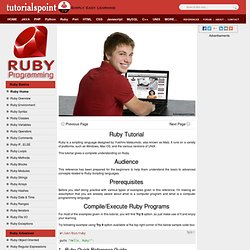
It runs on a variety of platforms, such as Windows, Mac OS, and the various versions of UNIX. This tutorial gives a complete understanding on Ruby. This reference has been prepared for the beginners to help them understand the basic to advanced concepts related to Ruby Scripting languages. Before you start doing practice with various types of examples given in this reference, I'm making an assumption that you are already aware about what is a computer program and what is a computer programming language. For most of the examples given in this tutorial, you will find Try it option, so just make use of it and enjoy your learning. Try following example using Try it option available at the top right corner of the below sample code box:
15 Things for a Ruby Beginner. The following is a post I had recently sent the Bangalore Ruby User Group. It has been slightly modified to address a larger audience. There were many Ruby beginners in last week's meetup, and the common question we heard was 'after the very basics, what next? ' The best way to learn Ruby best practices is to pair with an experienced dev; the way I learned was by inheriting a reasonably small, but well-written codebase from an amazing colleague.
In the absence of either, here is a checklist of 15 things (since 'N things that you need to know about X' is the in-thing these days!) 14 Ways To Have Fun Coding Ruby. 14 Ways To Have Fun Coding Ruby This guest post is contributed by Jeff Schoolcraft, who runs The Queue Incorporated a freelance consultancy that provides custom software development in Ruby, Rails and iOS. He produces screencasts with his partner, Istvan Hoka, at BDDCasts.
When he’s not building his business he’s trying to keep up with his two daughters and spending the rare free moment with his wife. You can read his blog and follow him on twitter @jschoolcraft. Ryanb/ruby-warrior. Codewars. Data Structures and Algorithms with Object-Oriented Design Patterns in Ruby. Iwanttolearnruby. What is ruby? SingPath - The Most Fun Way to Practice Software. The Ruby Toolbox - Know Your Options! Metaprogramming in Ruby: It’s All About the Self. November 15th, 2009 After writing my last post on Rails plugin idioms, I realized that Ruby metaprogramming, at its core, is actually quite simple. It comes down to the fact that all Ruby code is executed code–there is no separate compile or runtime phase. In Ruby, every line of code is executed against a particular self.
Consider the following five snippets: All five of these snippets define a Person.species that returns Homo Sapien. These snippets all define a method called name on the Person class. Delightful lessons for dedicated programmers. Ruby Koans Online.
The Basics of Ruby Arrays. An array is a list of items in order (like vitamins, minerals, and chocolates). Those keeping score at home might be interested to know that the Rails website framework makes 771 calls to Array.each, 558 calls to Array.map, and 1,521 calls to Array.empty? , not to mention the 2,103 times it accesses a single element inside an array. But these are just numbers. 15 Things for a Ruby Beginner. Learn Ruby on Rails: the Ultimate Beginner's Tutorial. Object Oriented Programming in Ruby Let’s build on the theory that we covered at the start of this chapter as we take a look at Ruby’s implementation of OOP. As we already know, the structure of an application based on OOP principles is focused on interaction with objects. These objects are often representations of real-world objects, like a Car. Interaction with an object occurs when we send it a message or ask it a question. If we really did have a Car object called kitt (we don’t — yet), starting the car might be as simple as: irb> kitt.start This short line of Ruby code sends the message start to the object kitt.
Using select, reject, collect, inject and detect. - matthew. Hackers and Painters. Learn to Program. Want to receive a weekly email containing the scoop on our new titles along with the occasional special offer? Just click the button. (You can always unsubscribe later by editing your account information). A Beginner's Guide To Ruby. Writing our own Class in Ruby: Ruby Study Notes - Best Ruby Guide, Ruby Tutorial.
So far, the procedural style of programming (this continues to be used in languages such as C) was used to write our programs. Programming procedurally means you focus on the steps required to complete a task without paying particular attention to how the data is managed. In the Object-Orientation style, objects are your agents, your proxies, in the universe of your program. Classes, Objects, and Variables @ Programming Ruby. From the examples we've shown so far, you might be wondering about our earlier assertion that Ruby is an object-oriented language. Well, this chapter is where we justify that claim.
Ruby Modules and Mixins. Modules are a way of grouping together methods, classes, and constants. Modules give you two major benefits. Modules provide a namespace and prevent name clashes.Modules implement the mixin facility. Ruby constructs: class, module and mixin. Ruby in Twenty Minutes. So, looking deeper at our new program, notice the initial lines, which begin with a hash mark (#).
On-line. Books.